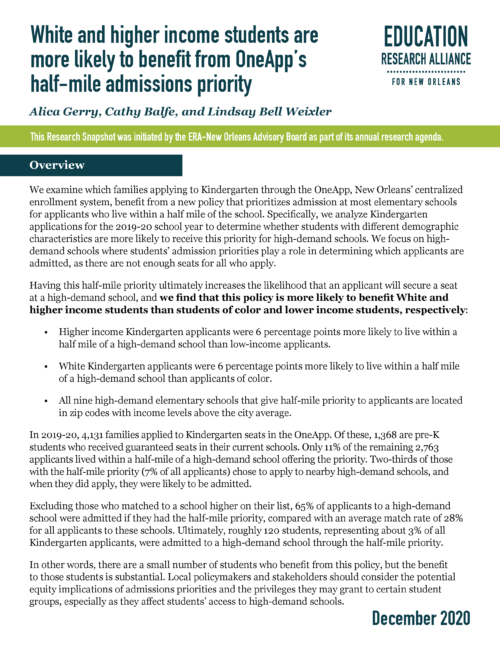White and Higher Income Students are More Likely to Benefit From OneApp’s Half-mile Admissions Priority
A Research Snapshot by Alica Gerry, Cathy Balfe, and Lindsay Bell Weixler finds that White and higher income students are more likely to benefit from a recent OneApp policy change that allows schools to prioritize admission for applicants who live within a half mile of the school.

White and Higher Income Students are More Likely to Benefit From OneApp’s Half-mile Admissions Priority
Published
by Alica Gerry, Cathy Balfe, Lindsay Bell Weixler
A recent policy change in New Orleans allows schools to prioritize admission for applicants who live within a half mile of the school. To see which students are most likely to benefit from this new policy, which first took effect last school year, Tulane University researchers Alica Gerry, Cathy Balfe, and Lindsay Bell Weixler examine 2019 – 20 Kindergarten applications in the OneApp, the centralized enrollment system for New Orleans’ almost all-charter school district. They find that having this half-mile priority ultimately increases the likelihood that an applicant will secure a seat at a high-demand school, and this policy is more likely to benefit White and higher income students than students of color and lower income students, respectively. The researchers define a school as “high demand” if all of its open seats were filled during the OneApp’s main round. The key findings are as follows: — Higher income Kindergarten applicants were 6.1 percentage points more likely to live within a half mile of a high-demand school than low-income applicants. — White Kindergarten applicants were 5.7 percentage points more likely to live within a half mile of a high-demand school than applicants of color. — All nine high-demand elementary schools that give half-mile priority to applicants are located in zip codes with income levels above the city average. In 2019 – 20, 4,131 families applied to Kindergarten seats in the OneApp. Of these, 1,368 are pre‑K students who received guaranteed seats in their current schools. Only 11% of the remaining 2,763 applicants lived within a half-mile of a high-demand school offering the priority. Two-thirds of those with the half-mile priority (7% of all applicants) chose to apply to nearby high-demand schools, and when they did apply, they were likely to be admitted. Excluding those who matched to a school higher on their list, 65% of applicants to a high-demand school were admitted if they had the half-mile priority, compared with an average match rate of 28% for all applicants to these schools. Ultimately, roughly 70 students, representing about 2.5% of all Kindergarten applicants, were admitted to a high-demand school through the half-mile priority. In other words, there are a small number of students who benefit from this policy, but the benefit to those students is substantial. Local policymakers and stakeholders should consider the potential equity implications of admissions priorities and the privileges they may grant to certain student groups, especially as they affect students’ access to high-demand schools.
Related Publications
Do Students Perceive Their Teachers and Schools More Positively When More of Their Teachers Look Like Them?
Sep 23, 2020 | by Alica Gerry, Lindsay Bell Weixler
Will the Arts Come Marching In? Access to Arts Education in Post-Katrina New Orleans
Sep 15, 2020 | by Sarah Woodward
Why Do Some Charter School Teachers Try to Unionize?
Aug 11, 2020 | by Huriya Jabbar, Jesse Chanin, Jamie Haynes, Sara Slaughter

